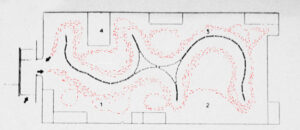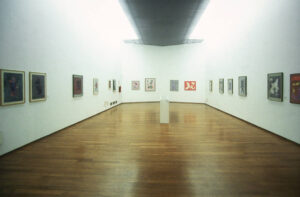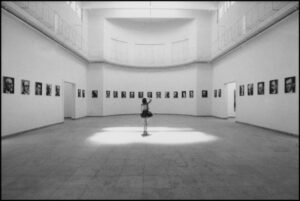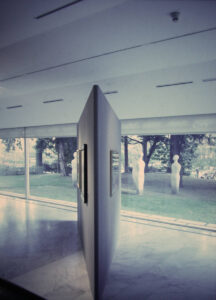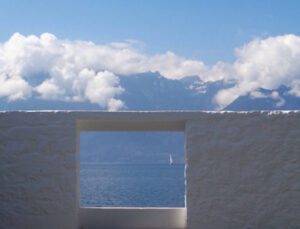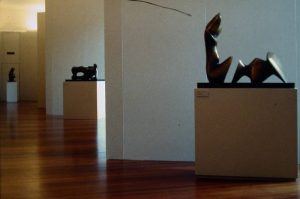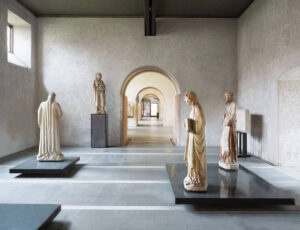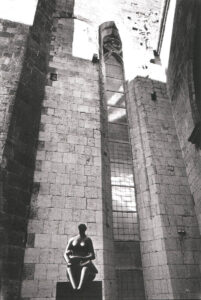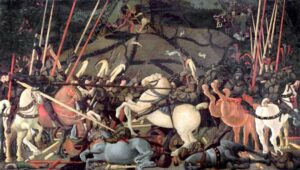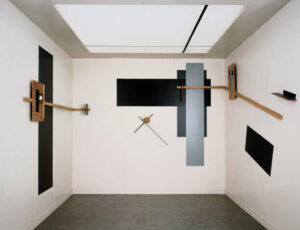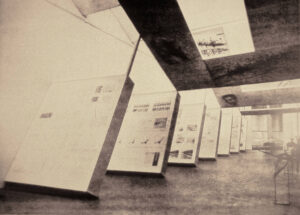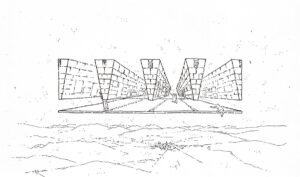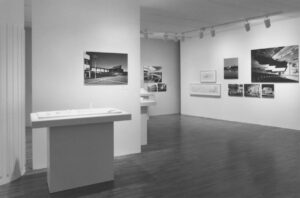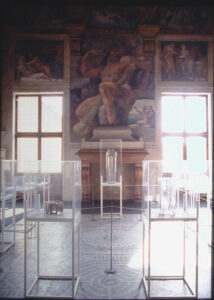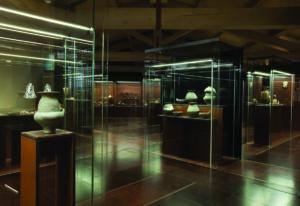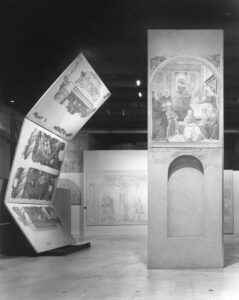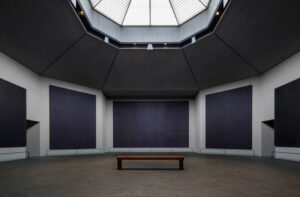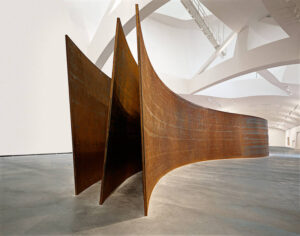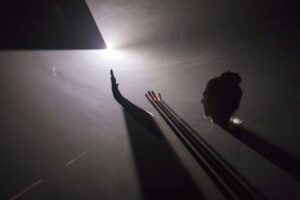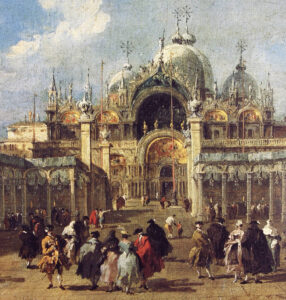INTRO ARCHITETTURE
29 settembre 2021
![]()
(English translation at bottom)
Premessa
Anni fa, lasciando Milano e -di conseguenza- la Facoltà del Design, per congedarmi da studenti, colleghi ed amici, e per rispondere alle gentili insistenze del preside Alberto Seassaro, avevo raccolto e strizzato in uno svelto librettino –progettar mostrando– la sostanza di alcune delle mie riflessioni in materia di exhibition design.
Il libretto fu accolto favorevolmente come un affettuoso promemoria dai miei ex-allievi, e fu liquidato da altri lettori -forse non a torto- come un testo ‘troppo criptico’ o ‘troppo filosofico’ o ‘troppo breve’.
Una delle possibili cause della diversità dei giudizi fu anche -credo- non tanto nella differenza tra i destinatari del messaggio, quanto nella differenza tra i mezzi di trasmissione: molte immagini e pensieri ad alta voce nelle lezioni o nelle revisioni -che studenti e colleghi ricordavano-, neanche un’immagine e soltanto parole scritte nel libretto.
A settembre del 2020, alcuni docenti di diverse scuole di design mi hanno chiesto dove poter trovare copie di progettar mostrando per i loro studenti. Ho risposto, dispiaciuto, che non era più possibile.
Tuttavia, per soddisfare almeno la sostanza di queste richieste -ma cercando di non ripetere gli errori del passato- ho pensato di cominciare a mettere in rete un po’ alla volta, con alcuni aggiornamenti, le trasposizioni delle tracce delle mie lezioni ed una selezione delle immagini che ne possono documentare i temi.
Le trasposizioni -alla fine saranno circa 25-30?- non sono più sintetiche tracce, ma neanche compiutamente lezioni. Dapprima, le ho chiamate pillole, pensando alla loro brevità e -mi auguro- alla loro assimilabilità. Poi, su suggerimento di chi -per sua cortesia- ha cominciato la difficile opera di traduzione in inglese, le ho rinominate clip, termine che meglio rispecchia la loro struttura e la loro funzione.
Precisazioni
Le clip -o pillole, ossia i file- che seguono ripropongono tracce di lezioni destinate a coloro che si stanno avvicinando al mondo dell’exhibition design, ed espongono, spesso sommariamente, solo le nozioni elementari, l’abc del progetto di allestimenti.
La loro origine e il loro scopo rendono dunque inevitabili -e forse doverose- una certa ridondanza e ripetitività di temi e argomenti.
Ogni traccia affronta temi circoscritti: temi e problemi progettuali, non storiografici. Perciò, quasi nessuno degli allestimenti citati viene documentato nella sua interezza, e tanto meno se ne propone una recensione, mentre ne vengono messi in evidenza solo gli aspetti e i particolari utili a illustrare quei temi.
Creative commons
Tutte le immagini e le fotografie di cui non sono indicati l’autore e la fonte sono di Nicola Marras.
I testi e le immagini di opere di Nicola Marras qui presenti sono liberamente riproducibili, a condizione che non ne sia fatto uso commerciale e che siano citate la fonte, l’autore dell’opera e l’autore della fotografia.
Le immagini di opere di autori diversi riprodotte in questo sito rispondono alla pratica del fair use (copyright act 17 USC 107 e art. 70 della legge n. 633/1941) essendo finalizzate al commento storico critico e all’insegnamento. Di ognuna di esse viene segnalato autore e fonte.
Alle stesse regole si attengono i contributi di terzi -sotto la loro responsabilità- e le eventuali traduzioni dei testi.
Contributi esterni
Le clip propongono riflessioni aperte alla discussione, e perciò al contributo di tutti coloro che sono interessati all’exibition design.
I materiali ritenuti interessanti -documenti, immagini, commenti alle clip, integrazioni, osservazioni, traduzioni, etc.- inviati a nm.lest@gmail.com saranno pubblicati su questo sito.
Gli autori che inviano i loro contributi alla riflessione danno il consenso alla loro pubblicazione senza nulla pretendere e ne sono garanti in tutto e per tutto, sollevando i redattori di questo sito da ogni responsabilità, ivi comprese quelle relative ad eventuali violazioni dei diritti di proprietà intellettuale.
Traduzioni
Tutte le clip saranno via via tradotte in inglese.
Ogni nuova traduzione sarà segnalata nell’indice da una bandierina e sarà inserita in coda al testo originale italiano. L’autore della traduzione -a sua richiesta- sarà indicato alla fine del testo.
……………………………………………………………………………………………………………………………………………….
![]()
elementary notions about design for the staging of an exhibition
29 September 2021
Premises
Few ears ago, when I left Milan and -consequently- the Faculty of Design, to take my leave as students, colleagues and friends, and to respond to the kind insistence of Preside Alberto Seassaro, I had collected and squeezed into a quick booklet –progettar mostrando– the substance of some of my reflections on exhibition design.
The booklet was welcomed as an affectionate reminder by my former students, and was dismissed by other readers -perhaps not wrongly- as a text ‘too cryptic’ or ‘too philosophical’ or ‘too short’.
One of the possible causes of the diversity of judgments was also -I believe- not so much in the difference between the recipients of the message, but in the difference between the means of transmission: many images and thoughts out of loud in the lectures or reviews -that students and colleagues remembered-, not even an image and only words written in the booklet.
In September of 2020, some teachers from different design schools asked me where they could find copies of progettar mostrando for their students. I replied, sorry, that it was no longer possible.
However, to satisfy at least the substance of these requests -but trying not to repeat the mistakes of the past- I thought I’d start posting on my website a little at a time, with some updates, the transpositions of the traces of my lectures and a selection of the images that documented the themes.
The transpositions -at the end will be about 25/30? – are no longer synthetic traces, but not even fully lectures. At first, I called them pillole (pills), thinking of their brevity and -I hope- their assimilation. Then, at the suggestion of one who -by her own courtesy- began the difficult work of translation in English, I renamed them clips, a term that best reflects their structure and function.
Specifications
The clips -or pills, namely the files- that follow propose traces of lectures intended for those who are approaching the world of exhibition design, and expose, often summarily, only the elementary notions, the abc of the staging design.
Their origin and purpose therefore make inevitable -and perhaps due- a certain redundancy and repetitiveness of themes and topics.
Each clip deals with limited themes: about design, not history. Therefore, almost none of the above exhibition is fully documented, much less a review is proposed, while only the aspects and details that are useful to illustrate those themes are highlighted.
Creative commons
All images and photographs of which no author and source are indicated are by Nicola Marras.
The texts and images of works by Nicola Marras present here are freely reproducible, provided that they are not used commercially and that the source, the author of the work and the author of the photograph are cited.
The images of works of different authors reproduced in this site respond to the practice of fair use (copyright act 17 USC 107 and art. 70 of the Italian law n. 633/1941) being finalized to the critical historical commentary and teaching. Of each of them is reported author and source.
The same rules apply to the contributions of third parties -under their responsibility- and any translations of texts.
External contributions
The clips propose reflections open to discussion, and therefore to the contributions of all those who are interested in exibition design.
The materials deemed interesting -documents, images, comments to clips, integrations, observations, translations, etc.- sent to nm.lest@gmail.com can be published on this website by reporting author and sources.
The authors or institutions that send their contributions to the reflection give consent to their publication without any claim and are guarantors in all respects, relieving the editors of this website from any responsibility, including those relating to any intellectual property rights.
Translations
All clips will be translated into English bit by bit.
Each new translation will be marked in the index by a flag and will be inserted at the end of the original Italian text. The author of the translation -at his request- will be indicated at the end of the text.
Edificio per uffici PIPPO PLUTO
parole e idee all’inizio delle clip
![]()
terminology – terms and concepts at the beginning of the clips
.
clip 01: percorsi – prime nozioni
tracciati, successione temporale, simultaneità
![]()
paths – first notions: traces, temporal succession, simultaneity
.
clip 02: percorsi – una galleria
mostra Omaggio a Gillo Dorfles – il pittore clandestino
la quadreria
.
clip 03: percorsi – gallerie e rotonde
punteggiatura
mostra Omaggio a Gillo Dorfles – il pittore clandestino – biografia e sogni
.
clip 04: percorsi – cominciamo a parlare di spazio
mostra Omaggio a Gillo Dorfles – il pittore clandestino
seconda sezione: il MAC
![]()
paths – we start talking about space and place
.
clip 05: quinte, soglie, traguardi, fànfole
la finestra sul lago di Le Corbusier, la Strada Novissima a Venezia,
Palazzo Abatellis a Palermo
agg. 28/02/2022
fifths, thresholds, traguardi, fànfole
.
clip 06: soglie, traguardi e strutture provvisorie
mostra Henry Moore, gli ultimi dieci anni a Bellinzona – interni
mostra Le Corbusier pittore e scultore a Venezia
.
clip 07: allestimento e architettura -1
Carlo Scarpa, la Galleria delle Sculture a Castelvecchio, Verona
agg. 20/01/2022
![]()
exhibition staging and architecture
.
clip 08: ancora soglie e traguardi
la mostra Henry Moore, gli ultimi dieci anni
nelle corti di Castelgrande a Bellinzona e del Maschio Angioino a Napoli
.
clip 09: luoghi e mostre
Castello di Rivoli, Villa Borghese
Alberto Giacometti a Roma e a Venezia
agg. 13/02/2022
![]()
site & exhibition
.
clip 11: luogo e allestimento – 2
Terragni: la sala “O” nella Mostra della Rivoluzione Fascista e la sala del Canottaggio nella Mostra dello Sport Italiano
Mostra dell’Aeronautica
.
clip 12: allestimento e architettura – 2
mostra I musei di James Stirling, Michael Wilford & Associates
Bologna, Galleria d’Arte Moderna – Fiera di Bologna
.
.
clip 13.1: luogo e allestimento 3
Alvar Aalto dal MoMA di New York a Palazzo Te di Mantova
parte prima
New York
.
clip 13.2: luogo e allestimento 3
Alvar Aalto dal MoMA di New York a Palazzo Te di Mantova
parte seconda
Mantova e altre riflessioni
agg. 8/07/2021
.
clip 14: il buio, per vedere
Dialogo nel Buio – mostra Quando il latte diventa Centrale
mostra Idoli – il potere dell’immagine – raccolta archeologica Collezione Pallavicini
.
clip 15: il buio e i luoghi
mostra Baj – opere 1951-2003 – Milano, 2003
Carlo Scarpa, mostra Frescoes from Florence (Affreschi fiorentini) – Hayward Gallery, Londra 1969
.
clip 16: Mark Rothko, arte e allestimento
la cappella Rothko a Houston
clip 17.1: luogo, arte, allestimento
Enzo Mari, The big stone game
Richard Serra, The Matter of Time
clip 17.2: luogo, arte, allestimento
Pirro Ligorio, il Sacro Bosco di Bomarzo, 1547
Anthony McCall, mostra Breath: the vertical works, 2009
clip 18: tecnologia, mercati, ideologie
la Fiera della Sensa a Venezia (1777), il Crystal Palace a Londra (1851),
ancora le mostre del fascismo in Italia (1930-1940), un progetto di Aldo Rossi (1988)
alcune riflessioni
.
